1. Shure SM7B
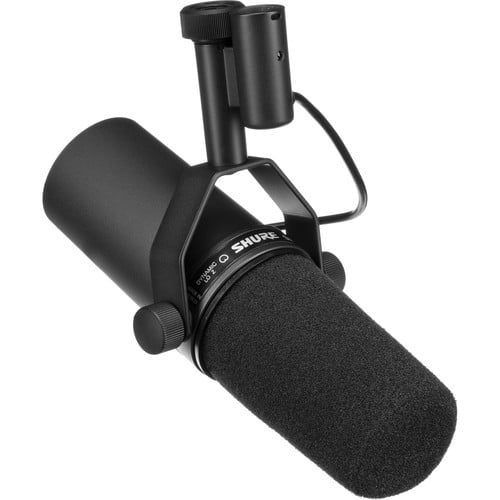
The Shure SM7B is a popular microphone choice for various recording applications, including broadcasting, podcasting, and studio vocal recording. Let’s break down its features:
Type of Microphone:
The Shure SM7B is a dynamic microphone. Dynamic microphones are known for their durability and ability to handle high sound pressure levels, making them suitable for capturing loud sources such as vocals and instruments.
Polar Pattern/Directionality:
The SM7B has a cardioid polar pattern. A cardioid microphone picks up sound primarily from the front and rejects sound from the sides and rear. This pattern helps to isolate the desired sound source and reduces unwanted background noise.
Frequency Response:
The frequency response of the SM7B is tailored for vocals and speech. It has a wide frequency range, typically ranging from 50Hz to 20kHz. This response allows for capturing the full tonal range of a voice, providing clear and natural-sounding recordings.
Impedance:
The SM7B has a relatively low impedance of 150 ohms. This impedance level is compatible with most audio interfaces and professional recording equipment, ensuring a strong signal transmission without the need for additional amplification.
Maximum Sound Pressure Level:
The SM7B can handle high sound pressure levels (SPL). It has a maximum SPL rating of 180dB, which means it can handle loud sources without distortion or clipping. This makes it suitable for capturing powerful vocals or instruments at close proximity.
Attenuation Switch:
The SM7B features a three-position switch known as the “Presence Boost” switch. This switch allows you to control the presence or brightness of the microphone’s output. The three settings are Flat (no boost), -6dB, and -15dB. This feature enables you to tailor the microphone’s response to suit different vocalists or recording scenarios.
In conclusion, the Shure SM7B is a dynamic microphone with a cardioid polar pattern, optimized frequency response for vocals, low impedance, high maximum sound pressure level handling, and a presence boost switch for added flexibility. These features make it a versatile and reliable choice for professional vocal recording, broadcasting, and podcasting applications.
2. Blue Yeti X
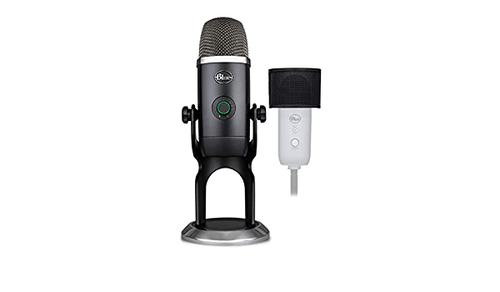
The Blue Yeti X is a popular USB microphone known for its versatility and high-quality sound. Let’s discuss its features:
Type of Microphone:
The Blue Yeti X is a condenser microphone. Condenser microphones are known for their sensitivity and ability to capture detailed audio. They are commonly used in studio recording and podcasting applications.
Polar Pattern/Directionality:
The Yeti X offers multiple polar patterns, including cardioid, bidirectional, omnidirectional, and stereo. The cardioid pattern is ideal for capturing sound from the front while rejecting background noise. The bidirectional pattern captures sound from the front and back, making it suitable for interviews or duets. The omnidirectional pattern captures sound from all directions, making it ideal for recording group conversations or ambient sound. The stereo pattern captures a realistic stereo image and is commonly used for music recording.
Frequency Response:
The Yeti X has a wide frequency response ranging from 20Hz to 20kHz. This range allows it to capture a broad spectrum of audio frequencies, resulting in clear and detailed recordings across different vocal and instrumental ranges.
Impedance:
The Yeti X has an impedance of 16 ohms. The low impedance ensures compatibility with most audio interfaces and computers, providing a strong and clean signal without the need for additional amplification.
Maximum Sound Pressure Level:
The Yeti X can handle high sound pressure levels. It has a maximum SPL rating of 122dB. This allows it to capture loud sources without distortion or clipping, making it suitable for capturing vocals, instruments, and other sound sources.
Attenuation Switch:
The Yeti X does not have a dedicated attenuation switch like the Shure SM7B. However, it does have an adjustable gain control knob on the microphone itself. This allows you to adjust the sensitivity of the microphone and control the input level, which can serve a similar purpose as an attenuation switch.
In conclusion, the Blue Yeti X is a versatile USB condenser microphone with multiple polar patterns, a wide frequency response, low impedance, high maximum sound pressure level handling, and an adjustable gain control. These features make it a popular choice for a wide range of recording applications, including podcasting, streaming, voiceovers, and music production.
3. Audio-Technica AT2035
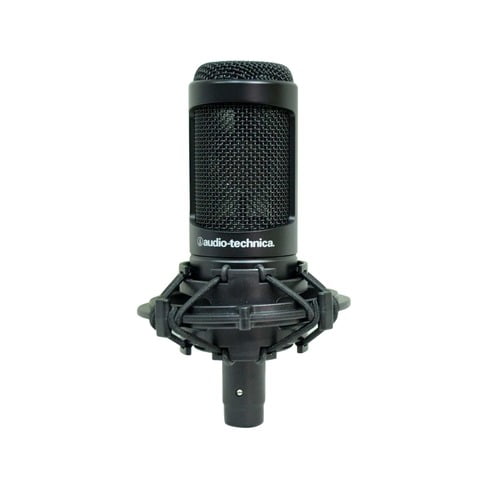
The Audio-Technica AT2035 is a popular large-diaphragm condenser microphone known for its versatility and audio quality. Let’s go through its features:
Type of Microphone:
The AT2035 is a condenser microphone. Condenser microphones are known for their sensitivity and ability to capture detailed audio. They require phantom power, typically provided by audio interfaces or mixing consoles, to operate.
Polar Pattern/Directionality:
The AT2035 has a cardioid polar pattern. It captures sound primarily from the front and rejects sound from the sides and rear. This pattern helps to isolate the desired sound source while reducing unwanted background noise and room reflections.
Frequency Response:
The AT2035 has a wide frequency response ranging from 20Hz to 20kHz. This range allows it to capture a broad spectrum of audio frequencies, making it suitable for recording vocals, acoustic instruments, and other sound sources with clarity and accuracy.
Impedance:
The AT2035 has a relatively low impedance of 120 ohms. This impedance level is compatible with most audio interfaces and ensures a strong and clean signal transmission without the need for additional amplification.
Maximum Sound Pressure Level:
The AT2035 can handle high sound pressure levels (SPL). It has a maximum SPL rating of 148dB with the pad engaged and 158dB without the pad. This means it can handle loud sound sources without distortion or clipping, making it suitable for capturing powerful vocals and instruments.
Attenuation Switch:
The AT2035 features a 10dB pad switch. This switch allows you to engage a 10dB attenuation pad, which reduces the sensitivity of the microphone. It comes in handy when recording extremely loud sources to prevent distortion or overload.
In conclusion, the Audio-Technica AT2035 is a versatile large-diaphragm condenser microphone with a cardioid polar pattern, wide frequency response, low impedance, high maximum sound pressure level handling, and a 10dB pad switch. These features make it a popular choice for recording vocals, acoustic instruments, podcasts, and other studio applications where accurate and detailed sound reproduction is desired.
4. Rode NT1-A
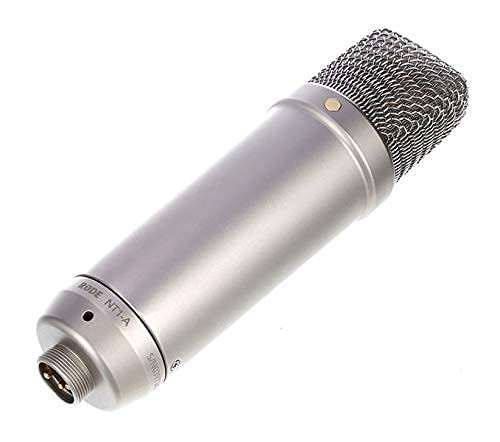
The Rode NT1-A is a popular large-diaphragm condenser microphone known for its low self-noise and clear sound reproduction. Let’s explore its features:
Type of Microphone
The Rode NT1-A is a condenser microphone. Condenser microphones are known for their sensitivity and ability to capture detailed audio. They require phantom power, typically provided by audio interfaces or mixing consoles, to operate.
Polar Pattern/Directionality:
The NT1-A has a cardioid polar pattern. It captures sound primarily from the front and rejects sound from the sides and rear. This pattern helps to isolate the desired sound source while reducing unwanted background noise and room reflections.
Frequency Response:
The NT1-A has a wide frequency response ranging from 20Hz to 20kHz. This range allows it to capture a broad spectrum of audio frequencies, resulting in clear and natural sound reproduction for vocals, instruments, and other sound sources.
Impedance:
The NT1-A has a low impedance of 100 ohms. This low impedance allows for a strong and clean signal transmission, making it compatible with most audio interfaces and recording equipment without the need for additional amplification.
Maximum Sound Pressure Level:
The NT1-A can handle high sound pressure levels (SPL). It has a maximum SPL rating of 137dB. This means it can handle loud sound sources without distortion or clipping, making it suitable for capturing powerful vocals and instruments.
Attenuation Switch:
The NT1-A does not have a built-in attenuation switch. However, it does come with an included shock mount that helps reduce mechanical vibrations and handling noise, contributing to cleaner recordings.
In conclusion, the Rode NT1-A is a high-quality large-diaphragm condenser microphone with a cardioid polar pattern, wide frequency response, low impedance, and the ability to handle high sound pressure levels. While it doesn’t have an attenuation switch, it includes a shock mount to enhance recording quality. These features make it a popular choice for professional vocal recording, studio applications, podcasting, and other situations where accurate and transparent audio capture is desired.
5. HyperX QuadCast
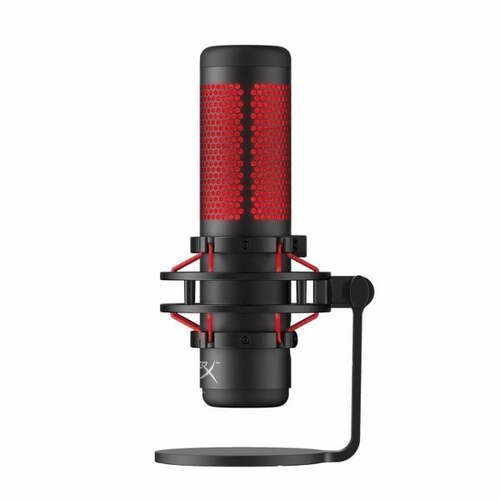 The HyperX QuadCast is a USB microphone designed for gamers, streamers, and content creators. Let’s delve into its features:
The HyperX QuadCast is a USB microphone designed for gamers, streamers, and content creators. Let’s delve into its features:
Type of Microphone:
The HyperX QuadCast is a condenser microphone. Condenser microphones are known for their sensitivity and ability to capture detailed audio. They require phantom power, which is provided through the USB connection.
Polar Pattern/Directionality:
The QuadCast offers four selectable polar patterns: stereo, omnidirectional, cardioid, and bidirectional. The stereo pattern captures sound from the left and right channels, creating a sense of depth and space. The omnidirectional pattern captures sound from all directions, making it ideal for recording group conversations or ambient sound. The cardioid pattern captures sound primarily from the front and rejects sound from the sides and rear, reducing background noise. The bidirectional pattern captures sound from the front and back, making it suitable for interviews or duets.
Frequency Response:
The QuadCast has a frequency response ranging from 20Hz to 20kHz. This range allows it to capture a wide spectrum of audio frequencies, providing clear and accurate reproduction of vocals, music, and other sound sources.
Impedance:
The QuadCast has an impedance of 32 ohms. This impedance level ensures compatibility with most audio interfaces and computers, providing a strong and clean signal without the need for additional amplification.
Maximum Sound Pressure Level:
The QuadCast can handle sound pressure levels (SPL) up to 120dB. While this is not as high as some other microphones, it is sufficient for most recording situations, including vocals, gaming, and streaming.
Attenuation Switch:
The QuadCast does not have a dedicated attenuation switch. However, it does feature a built-in shock mount to reduce unwanted vibrations and a pop filter to minimize plosive sounds. These features help improve the overall audio quality and reduce the need for additional attenuation.
In conclusion, the HyperX QuadCast is a versatile USB condenser microphone with four selectable polar patterns, a wide frequency response, moderate impedance, and the ability to handle typical sound pressure levels. While it doesn’t have a dedicated attenuation switch, it includes a shock mount and pop filter for improved audio quality. These features make it a popular choice for gaming, streaming, podcasting, and other content creation applications.
6. Blue Snowball Ice
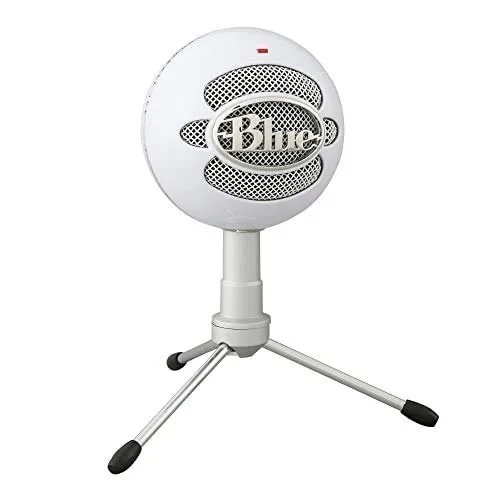
The Blue Snowball Ice is a popular USB microphone known for its simplicity and affordability. Let’s discuss its features:
Type of Microphone:
The Blue Snowball Ice is a condenser microphone. Condenser microphones are known for their sensitivity and ability to capture detailed audio. They require phantom power, which is provided through the USB connection in the case of the Snowball Ice.
Polar Pattern/Directionality:
The Snowball Ice has a cardioid polar pattern. It captures sound primarily from the front and rejects sound from the sides and rear. This pattern helps to isolate the desired sound source while reducing background noise and room reflections.
Frequency Response:
The Snowball Ice has a frequency response ranging from 40Hz to 18kHz. While not as wide as some other microphones, it is still sufficient for capturing vocals, speech, and general audio recording needs.
Impedance:
The Snowball Ice has an impedance of 16 ohms. This low impedance ensures compatibility with most audio interfaces and computers, providing a strong and clean signal without the need for additional amplification.
Maximum Sound Pressure Level:
The Snowball Ice can handle sound pressure levels (SPL) up to 120dB. While not extremely high, it is suitable for most recording scenarios, including vocals, podcasts, and conference calls.
Attenuation Switch:
The Snowball Ice does not have an attenuation switch. It is a simple plug-and-play microphone without additional controls or switches.
In conclusion, the Blue Snowball Ice is an affordable and easy-to-use USB condenser microphone with a cardioid polar pattern, a frequency response suitable for general audio recording, low impedance for compatibility, and a moderate maximum sound pressure level handling. While it lacks an attenuation switch, it offers a straightforward and convenient solution for users looking for a budget-friendly microphone for voice recording, online communication, and basic audio applications.
